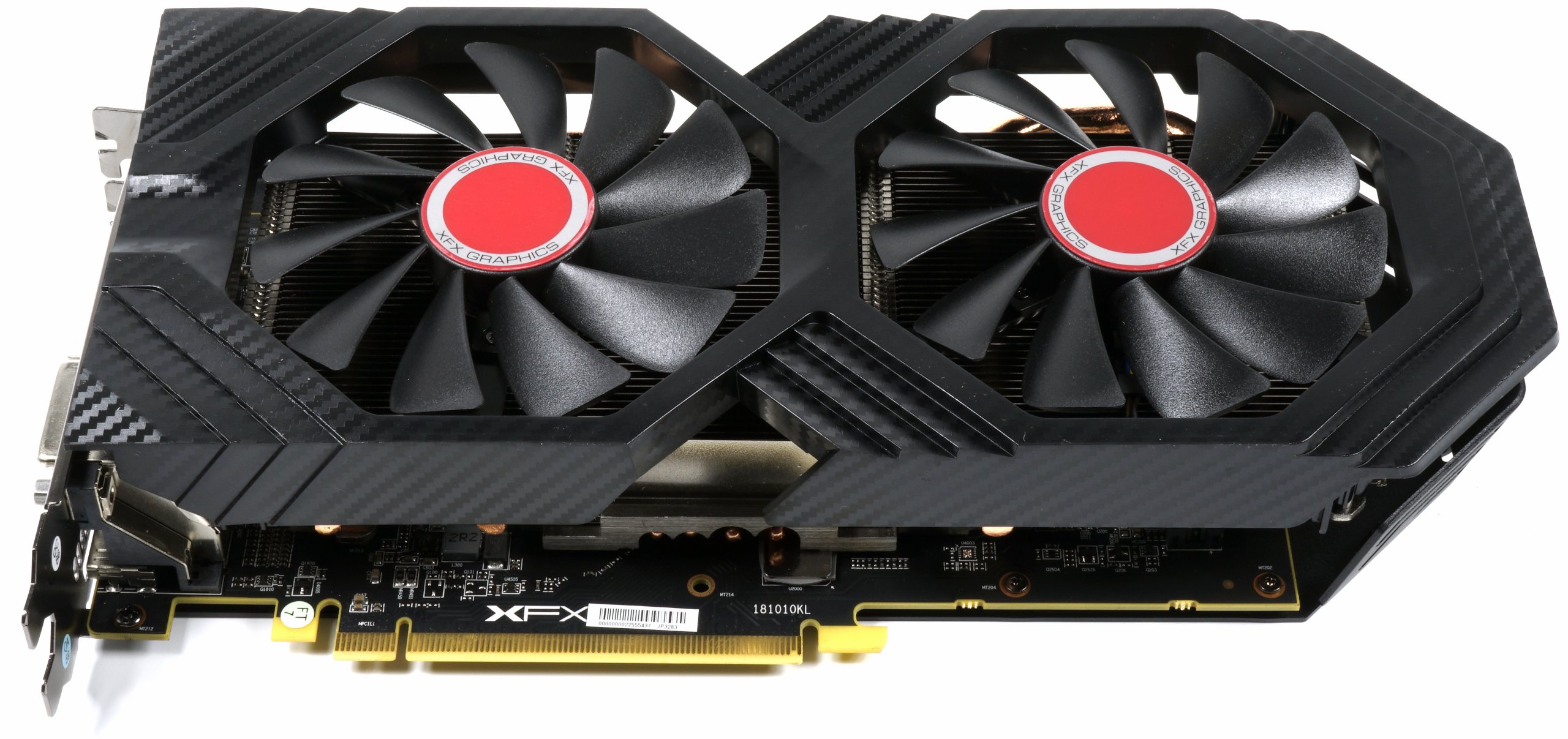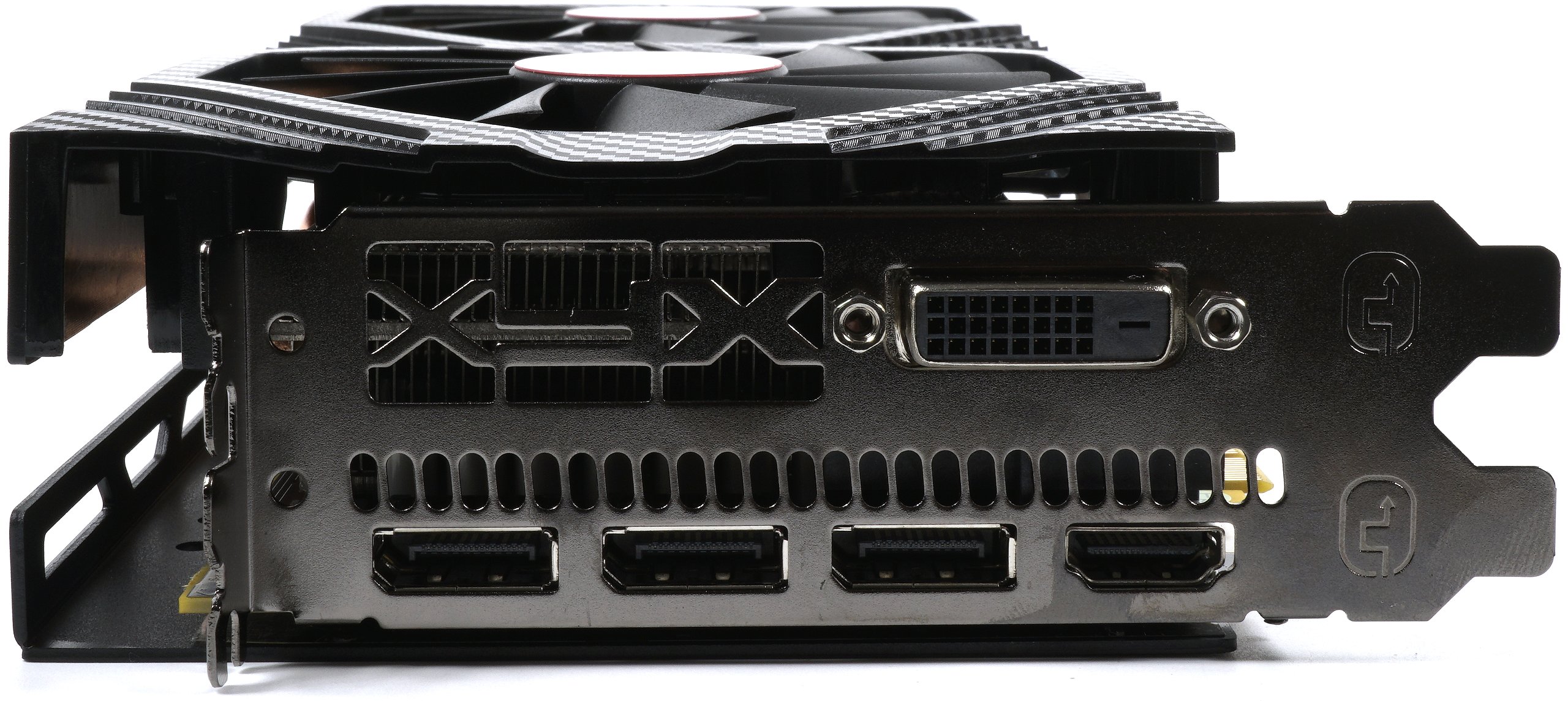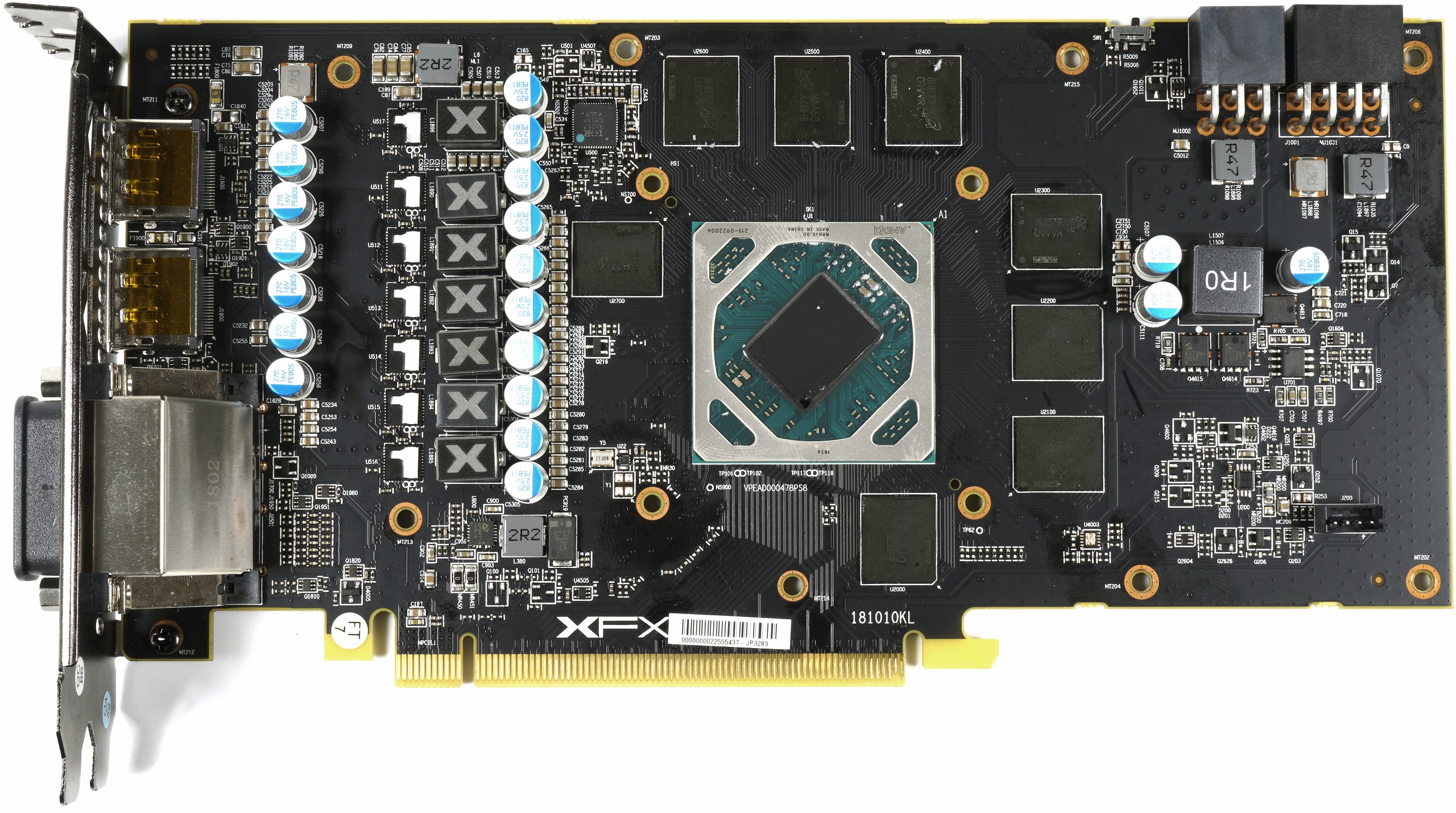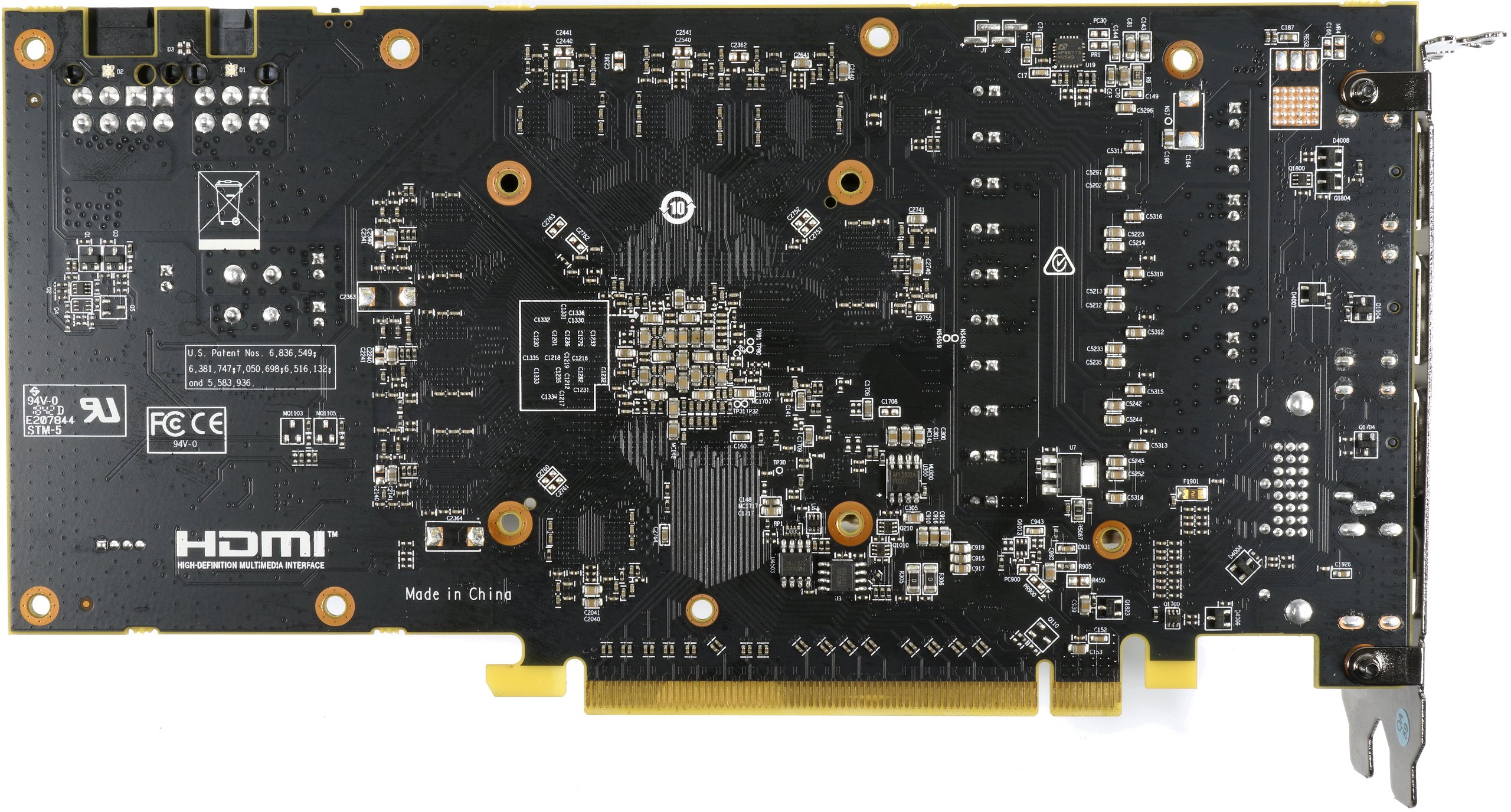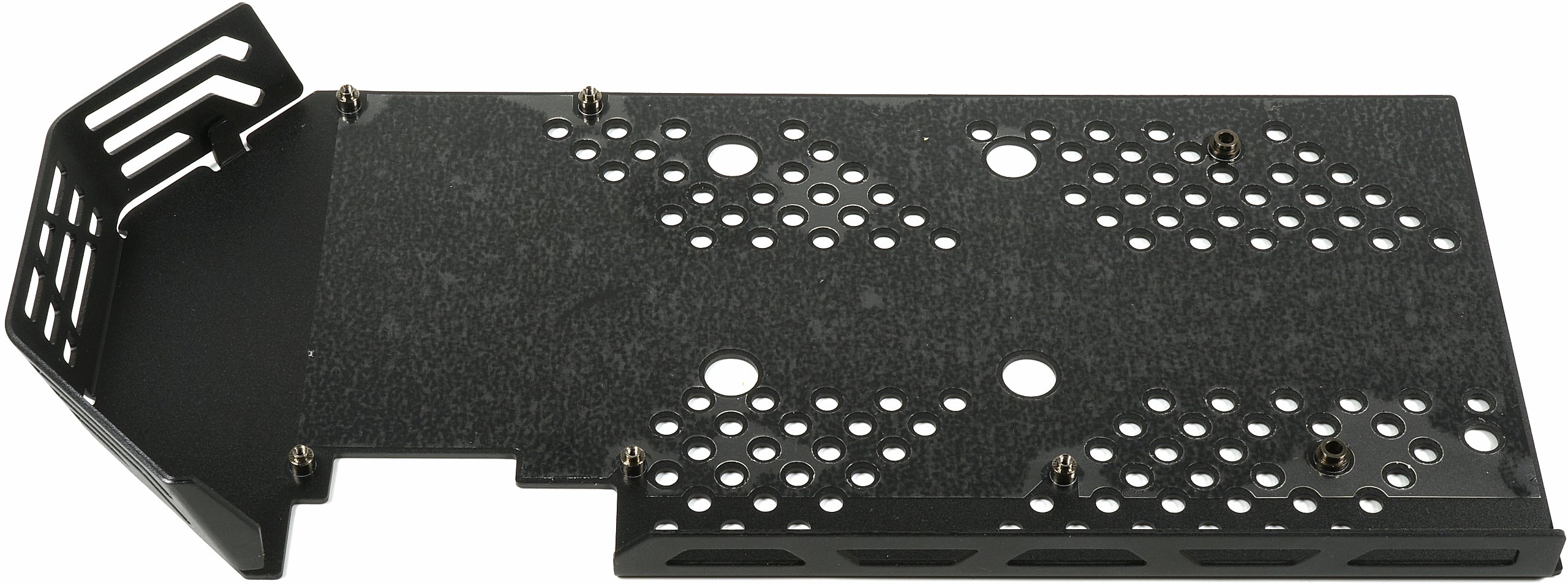Radeon RX 590 Review: AMD’s First 12nm GPU Hits 225W
Why you can trust Tom's Hardware
Meet the XFX Radeon RX 590 Fatboy 8GB OC+
XFX uses technology from its Radeon RX 580 GTS Black Edition, saving the company from having to rework the Radeon RX 590 Fatboy 8GB OC+.
The new card weighs in at 1.89lb (856g). From the edge of its slot panel to the end of its fan shroud, we measure 10.6 inches (26.8cm). The heat sink assembly is 1.7 inches (4.3cm) deep. However, you have to add another 0.2in (0.5cm) to account for the backplate. This is a true 2.5-slot card, meaning it takes up three expansion slots on your motherboard. A 4.8-inch (12.2cm) measurement from where the card sits in a PCIe slot to the cooler’s top edge is actually pretty tall, dwarfing our Founders Edition GeForce and reference Radeon RX Vega cards.
From the bottom, it’s easy to see that XFX’s heat sink employs aluminum fins oriented horizontally. We approve, since heated air isn’t pushed down toward your motherboard and out against a case wall. Rather, some is exhausted out the expansion slot cover.
We also catch a glimpse of four heat pipes that sit flat over a copper plate and dissipate thermal energy through the sink’s fins.
Up top, there’s an eight- and six-pin power connector, cluing us in that a shrink to 12nm doesn’t translate to power-savings from Radeon RX 590. Again, AMD’s board power rating is 225W compared to Radeon RX 580’s 185W specification.
XFX loads the slot bracket with five display outputs: three DisplayPort 1.4-ready connectors, HDMI 2.0, and one DVI-D port. Although we appreciate copious connectivity, the DVI output does take up room that could have been freed up for exhaust.
With its heat sink removed, the Radeon RX 590 Fatboy 8GB OC+ looks almost identical to the Radeon RX 580 GTS Black Edition. Again, XFX uses six power phases for the GPU and one phase for memory.
Get Tom's Hardware's best news and in-depth reviews, straight to your inbox.
There are hardly any components on the back side, except for two BIOS chips.
The following table lists the most important components on XFX’s PCB:
| GPU Power Supply | ||
| PWM Controller | IR35217 International Rectifier 6+2-Phase |
VRM6x IR3578 International Rectifier PowIRstage (High-side, Low-side, Schottky diode, driver)
Coils6x XL Ultra Low Noise Coils
Memory Power SupplyMemory Modules8x MT51J256M32HF-80:B Micron 8Gb GDDR5 Module (256Mb x32) 8.0 Gb/s at 1.5V
VRM1x IR3578 International Rectifier PowIRstage (High-side, Low-side, Schottky diode, driver)
Coils6x XL Ultra Low Noise Coils
Other ComponentsBIOS2x FM25Q02 EEPROM Dual BIOS
DIP SwitchPrimary/secondary BIOS
Smoothing1x 470mH coil per 12V supply connection
Cooler and Backplate
The hull-shaped backplate made of dark aluminum makes no contact with the board and doesn’t play a role in cooling. There are ventilation holes throughout, though, so at least the plate doesn’t trap heat underneath. The plate’s only purpose is to look good.
Because the backplate is screwed in from the PCB’s top side, the only way to remove it is disassembling the entire heat sink.
The cooler itself is a simple affair based on two 8mm and two 6mm heat pipes made of copper composite material. The pipes dissipate heat away from AMD’s Polaris chip and into a fin stack that spans both ends of the PCB. Underneath them is a thin copper plate that contacts the GPU die. A small frame surrounds the plate, sandwiching thermal pads between the metal and all eight memory modules.
This small thermal solution is tasked with removing as much as 250W from the board underneath. It’s more capable than AMD’s reference Radeon RX 480, but does reach its limit under load in a closed chassis.
| Thermal Solution At A Glance | |
| Type of Cooler | Air |
| GPU Heat Sink | Copper plate on heat pipes |
| Cooling Fins | Aluminum, horizontally-oriented, tight fin pattern |
| Heat Pipes | 2x 8mm + 2x 6mm, copper composite |
| VRM Cooling | Via its own heat sink |
| RAM Cooling | Via frame on heat sink |
| Fans | 2x 9.5cm fans, 11 rotor blades each, semi-passive mode |
| Backplate | Aluminum backplate, no cooling function |
MORE: Best Graphics Cards
MORE: Desktop GPU Performance Hierarchy Table
MORE: All Graphics Content
Current page: Meet the XFX Radeon RX 590 Fatboy 8GB OC+
Prev Page AMD Radeon RX 590 8GB Review Next Page How We Tested the Radeon RX 590 and Ashes of the Singularity-
shrapnel_indie The further cut-down Vega sounds like it could have been a better option to me, primarily if they could make it work with GDDR5, GDDR5X, or GDDR6 memory.Reply -
elbert Wonder if we will see a RX 590X in a month or 2. Higher bin chips passing this overclock and with say GDDR5x 9GB memory.Reply -
v71 A conclusion & a possible editorial mistake:Reply
1. A used GTX 1070 for slightly over $200 is a better value today for 2k gaming.
2. It seems that in GTA V & Metro the slides were mislabled - the 1080p were placed under 2k and viceversa. Look at the presented framerates in those two games & you'll see that 1080p results are worse than 2k;) -
tslot05qsljgo9ed I hope you are joking because this RX 590 is the already the higher bin chips.Reply -
cangelini Reply21488265 said:A conclusion & a possible editorial mistake:
1. A used GTX 1070 for slightly over $200 is a better value today for 2k gaming.
2. It seems that in GTA V & Metro the slides were mislabled - the 1080p were placed under 2k and viceversa. Look at the presented framerates in those two games & you'll see that 1080p results are worse than 2k;)
Good eye! :)
The perf difference is actually from turning off SSAA at 2560x1440 in Metro and disabling 4xAA at 2560x1440 in GTAV as we try to keep QHD a playable resolution. Maintaining the same quality settings would have hit that res too hard. -
mohit9206 238W of power while gaming? That is unacceptable. 7nm cards can't come soon enough for AMD.Reply -
hannibal Reply21488220 said:The further cut-down Vega sounds like it could have been a better option to me, primarily if they could make it work with GDDR5, GDDR5X, or GDDR6 memory.
Yep, but that would require complete remaking that chip. Well Hopefully good Ryzen selling Numbers give money Also to gpu department so that They can afford to completely rehaul their low end and middle range cards. Even this 12nm with that 7.5 library would offer good gains if paineen with refress in architecture. But that remain to later timeframe. New card will require a couple of years, so if and because the company is in right track, one or two years From now there will be improvements if They start now the developmening it. -
mohit9206 Quote from anandtech reviewReply
"Once again though, we've observed that VRAM is never enough. It was only a few years ago that 8GB of VRAM was considered excessive, only useful for 4K. But especially with the popularity of HD texture packs, even 6GB of framebuffer could prove limiting at 1080p with graphically demanding games. In that respect, the RX 590's 8GB keeps it covered but also brings additional horsepower over the 8GB R9 390. For memoryhogging games like Shadow of War, Wolfenstein II, or now Far Cry 5 (with HD textures), the 8GBs go a long way. Even at 1080p, GTX 980/970 performance in Wolfenstein II tanks because of the lack of framebuffer. For those looking to upgrade from 2GB or 4GB cards, both the RX 580 and RX 590 should be of interest."
So as you can see 480/580 and 590 do benefit from the extra vram even at 1080p. I do feel all those people who asked on various forums on whether to buy 4gb or 8gb and got recommended 4gb since they were playing at 1080p were wronged as just a year or two later games are now benefitting from larger than 4gb framebuffer. Now those people will have to upgrade their cards sooner rather than if they had 8gb model they would have been able to keep the card longer.The forums can sometimes give wrong advice to people and screw them over. -
AgentLozen AMD got some awful diminishing returns from overclocking a 580. I wonder if we would see better returns if they reconfigured the cores and ROPs instead of using a 580 as the foundation.Reply
I'm disappointed with the 14nm -> 12nm transition. It seems like it did nothing to help with power consumption or heat. I was hopeful because it was helpful in regards to AMD's Ryzen chips.
